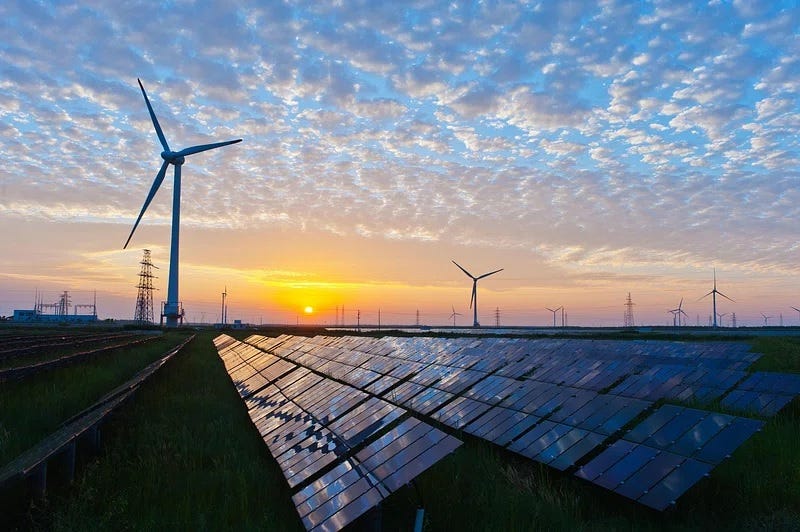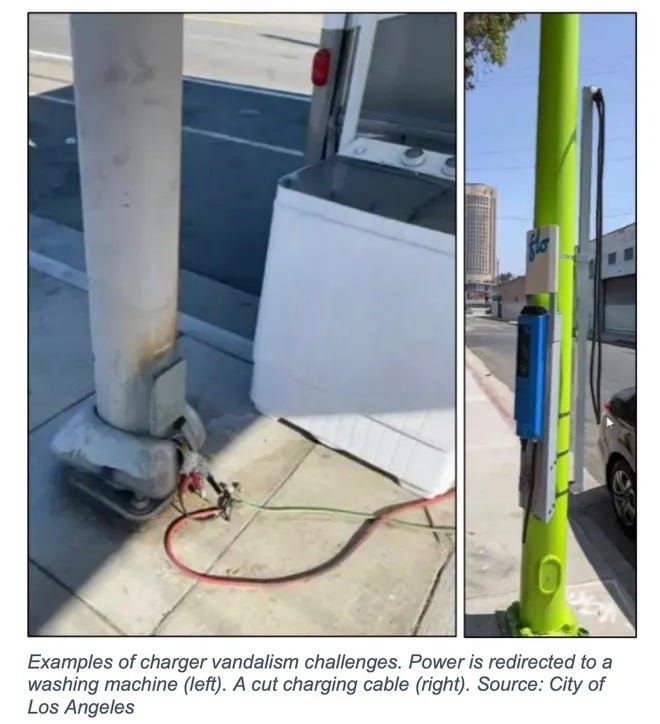So Much Clean Energy News!
We gotta wear shades.

Yesterday afternoon we were casting around for something to write, and just as we were wondering if we’d have to settle for a sad awful guns story, suddenly a whole pile of climate and clean energy stories tumbled out of the internet onto our head like a torrent of dead tribbles on Captain Kirk.
Fortunately, it wasn’t quite that many clean energy stories, and they Aten’t Dead, if you don’t mind a catchphrase from a different nerd entertainment. Let us dig in!
Q: Should We Be Pessimistic Or Optimistic About The Energy Transition? A: Yes!
We’ll start, as we so often do, with energy reporter David Roberts, whose Volts podcast on climate ‘n’ energy helps us avoid climate despair. On a recent episode, Roberts interviewed clean energy analyst Michael Liebreich about a pair of blog posts Liebreich wrote about “the five horsemen” and “five superheroes” of the transition to clean energy, forces (not individual people) that will make the transition to net zero much harder than you might think, but also much easier than you might worry.
The podcast is full of nerdy information, and while I won’t summarize the whole thing, I’ll say it left me with a better understanding of what we’re up against, like the huge cost of getting the last 30 percent or so of the transition finished once we deploy solar, wind, and batteries widely. Those challenges are especially tough in the developing world. And then there’s the politics of it all: not just getting people to engage with the issue, but also fighting off the powerful greedheads who can slow things down to protect profits.
But oh, the superheroes are impressive, and that was the part of the podcast where I kept saying “wow” at stuff I’d never given thought to before, like the fact that as renewable energy starts taking over, metric shit-tons of greenhouse emissions will fade away as the world stops devoting so much energy to sustaining the fossil fuel economy.
F’rinstance, 40 percent of ocean shipping today involves moving coal, oil, and fossil gas from one place to another, mostly on ships burning “bunker fuel,” itself among crude oil’s most polluting and carbon-intensive derivatives. Rebuild some of the ships to run on clean fuels, but scrap most for the steel — recycled using carbon-free processes. Ports then need fewer tugboats — which burn diesel or bunker oil — and other carbon-emitting infrastructure. And so on.
Another brain-exploder: Fossil fuels are so inefficient, wasting about two-thirds of their energy as heat, that we’ll actually need less renewable energy to replace it, at least in terms of “Primary Energy Demand,” the metric used to calculate the world’s total energy needs. Thing is, that metric includes all that wasted combustion that doesn’t make the car go or warm the house, so in terms of useful clean energy to replace it, you don’t need a one-to-one match, especially as the clean energy powers cleaner stuff like EVs and heat pumps and even little ol’ things like lightbulbs.
As Liebreich explains, if you replace a 75-watt incandescent bulb, lit by power from a (35 percent efficient) coal-burning power plant, with a 10-watt LED bulb powered by renewables, you’d reduce total energy “demand” by 95%, and with zero CO2 emissions — all while producing the same amount of light. Electric vehicles charged by solar? Zero emissions and 75 percent less Primary Energy Demand, but just as much travel. On the podcast, he notes that by one measure, the percentage of clean energy needed to replace all current fossil fuels is a reassuring 42, for all you Douglas Adams fans waving towels around.
Give the pod a listen or a read (link goes to both formats). It’s pretty cool!
[Volts / Leibreich blog part 1 / Liebreich blog part 2]
Batteries, Batteries, Batteries!
This New York Times story (gift link) about how grid-scale batteries are changing California’s energy landscape will gladden your heart and give you a better idea of what energy will look like as the transition moves forward.
As the story notes, one complication of getting more energy from the sun than any other state is that while solar powerful is plentiful during the day, peak energy use hits in the early evening. To meet that demand, California utilities had to turn on more fossil gas plants and import energy from other states.
But just as the cost of solar dropped sharply in recent years, giant batteries are becoming cheaper and being deployed more widely, and they’re beginning to replace some of the fossil fuel use in those evening hours. As the Times explains,
between 7 p.m. and 10 p.m. on April 30, for example, batteries supplied more than one-fifth of California’s electricity and, for a few minutes, pumped out 7,046 megawatts of electricity, akin to the output from seven large nuclear reactors.
Here’s the exciting thing: This is just the start. In just the last three years, US grid battery storage capacity
has grown tenfold, to 16,000 megawatts. This year, it is expected to nearly double again, with the biggest growth in Texas, California and Arizona.
As we like to say, terrific article, go read the whole thing!
And if you really want to dig into how clean energy will keep the power on even when the sun isn’t shining and the wind isn’t blowing, here’s another Volts podcast for you, looking at the solutions that are already in use and those that are in development.
Charge Your EV At The Nearest Streetlight
Here’s a neat little story about a plucky startup, Voltpost, that thinks it has a solution to the problem of charging electric vehicles in urban areas where people can’t just plug the car in overnight in the garage, because no garage: Just find a streetlight, step out of the shade, and say “You and me, babe, how about it?” The company’s modular design for level-2 EV chargers takes advantage of the fact that streetlights are already connected to the grid, so there’s your power, with no need to dig up the streets and sidewalks to connect to power.
It’s also designed to survive on America’s mean streets, where clumsy drivers and malicious jerks can quickly take streetside EV chargers out of action.
Neat story, go read it, and enjoy the above photo from a US government report on curbside and other charging solutions, showing the work of an enterprising electricity pirate who dragged a washing machine onto a sidewalk and powered it from a light post. Don’t try that at home, please. [Canary Media]
Live In Colorado? Buying An E-Bike? There’s A Tax Credit For That!
In April, Colorado rolled out a $450 point-of-purchase tax credit on the purchase of qualifying electric bikes (that’s most of ‘em) from participating retailers (not all of ‘em). You don’t even need to have a tax liability to take advantage of the deal. Any Colorado resident — including students going to school there! — qualifies to buy one e-bike a year.
Full details, participating dealers, bike guidelines, and necessary documents (to prove you live in Colorado and aren’t sneaking in from Kansas for e-bike bennies) at the Colorado Energy Office.
Minnesota Replaces Coal Plant With Solar, You Bet!
We usually think solar energy is for places like California or Texas or Arizona, but one of the biggest solar projects in the USA is just about to go into service in Minnesota, where it’s being built “on former potato farms near the site of a retiring coal plant.”
Don’t worry, solar energy will not cause a potato shortage.
The Sherco solar and energy-storage facility will be the largest solar project in the Upper Midwest, and the fifth-largest in the U.S. by the time it’s fully completed in 2026. The first phase of the project should begin sending emissions-free electricity to the grid this fall, heralding the start of a new era in a state whose largest solar project until now has been just 100 megawatts. This new project will have a capacity of 710 megawatts.
Not only will it replace part of the 2,200-megawatt output of the retiring coal plant, it’ll also have a unionized workforce, with jobs and tax revenue for the community of Becker. Xcel Energy, the owner of both the coal plant and the new solar installation, plans to manage the transition without any layoffs, shifting some workers to the solar plant and others to its other facilities around Minnesota.
The solar plant will use the coal plant’s existing grid connection, avoiding the challenge of new transmission lines and navigating the “interconnection queue” — the long wait list for new grid connections. Best of all: The coal plant it’ll help replace is Minnesota’s single biggest source of greenhouse gas emissions.
Also extremely cool: It’ll be one of the nation’s first big energy facilities to use long duration iron-air batteries, which don’t need no stinkin’ lithium. These suckers will be
capable of storing 10 megawatts of power for up to 100 hours. That’s enough backup for the grid to ride out a plant shutdown from a weather event such as a polar vortex, and far more than the 4-hour duration of the lithium-ion batteries that now predominate grid storage.
The batteries are manufactured at a factory in West Virginia, which gives us the opportunity to say “Fuck Joe Manchin” one more time. [Canary Media]
Yr Wonkette is funded entirely by reader donations. If you can, please subscribe, or if a one-time donation gets you charged up, transfer your positive energy, converted into direct currency, using this handy button.






Cool that they're using iron-air batteries at the new Minnesota solar farm. Those things are WAY too heavy to use in cars (made of iron, people), but they're cheap and use no rare components that might require child labor in Africa or some shit. Ethical, sustainable, recyclable, and while they don't charge and discharge super quickly and are (as previously mentioned) heavy as hell, in these applications where they sit motionless on the ground they are just the fucking thing.
For those keeping track, the "next up" tech for grid and marine is calcium batteries. Now calcium isn't particularly heavy, but you have to understand that Lithium is the 3rd lightest element that there is, and the absolute lightest of any solid element (at least at useful temperatures and pressures). So calcium won't replace lithium in car batteries soon, but they're light enough to do so eventually, while having all of the advantages of iron batteries I've listed above except ease of recycling (they will still be recycled, but it is not as easy) PLUS the ability to charge and discharge quickly.
Different kinds of batteries for different applications is the point. Tesla wants you to pay extra for super-light batteries optimized for mobile applications instead of long lifetimes, ethical production, sustainability, and cheap prices even when those batteries will be sitting in one place for the next 10 years connected to your dishwasher. And because there was money to be made in super-mobile applications like cell phones and cars, the R&D priority on lithium ion batteries made sense and has given them a huge head start.
But lithium-ion was never the best battery for every application, and we're starting to see the alternatives hit genuine mass production. Honestly, this is the best energy news we've had in about 7 years.
Oh, I should probably note that, for length, I haven't really gone into some finer points here and there, but that for the most part, the linked stories cover most details you might have questions about.
One point I really loved from the Volts interview: Liebreich also points out that we can (mostly) dismiss worries that we simply can't mine enough minerals for all the batteries we'll need, at least outside temporary bottlenecks. One reason is that oil and gas and coal already use a lot of the minerals that could go into batteries of various designs.
Another is that within 30-40 years, battery (and other) recycling should be sufficient to provide around 95% of the materials needed for new applications, meaning new mining can be relatively minimal. No such efficiency when you're always digging up more fossil fuels to burn.
But no answers about how that washing machine got there, sorry. Like the watermelon in the lab in Buckaroo Banzai, it must forever remain a mystery. You could write fan fiction about it.